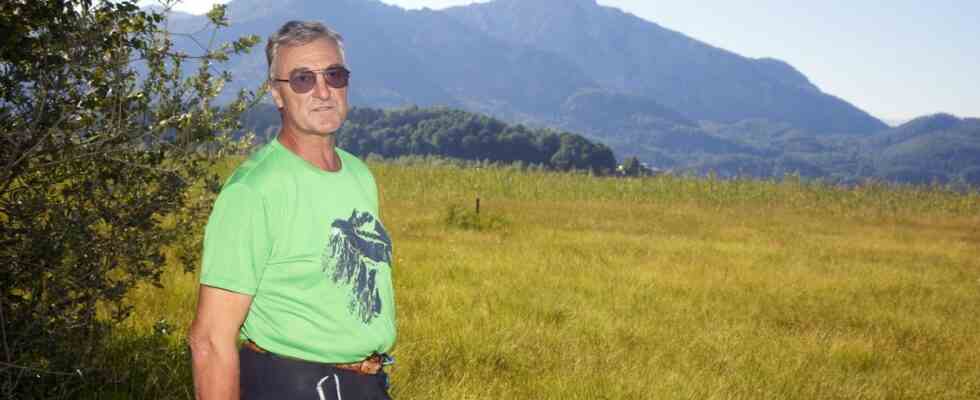From his terrace in Kochel, Max Lantenhammer can look across to the Jochberg, probably Munich’s most popular local mountain. More than 100,000 people climb it every year, and the way up is badly affected. “There is hardly any other mountain in the Bavarian Alps with such erosion damage,” said the 59-year-old. For the renovation, the path warden of the DAV section in Tutzing, together with the Kochel mountain photographer Bernd Ritschel, launched an action that has never been seen before: the hikers are to help carry tons of gravel and building material up the mountain for the path renovation. A conversation about overtourism, nature conservation and the desire to hike in the pandemic.
SZ: Mr. Lantenhammer, why is the Jochberg so popular?
Max Lantenhammer: I think because it’s doable for everyone. And of course the view of the Kochelsee and Walchensee and the mountains all around is fantastic.
100,000 hikers a year – is that too many for the mountain?
I don’t think there are too many. Our problem was that during the corona pandemic, everyone went to the mountains and the path quickly became unclear. The trail was last revised around 15 years ago. In the meantime, in some places you no longer even know how it runs, because people have paved new paths. I can go up as often as I want: most of the time even I end up on a shortcut, although I know the route really well.
What’s wrong with multiple paths and shortcuts?
The main problem is erosion. Where people walk, the soil loosens and is then carried away by water and weather. This creates aisles that are meter wide and nobody wants them. Nothing grows there anymore.
Because hikers take shortcuts, the actual path is hardly recognizable in many places.
(Photo: private)
Here the hiker can choose between three possible routes. After the renovation, there should only be one way.
(Photo: private)
Is it also about the protection of animals?
Of course too. The animals get used to a lot, but need their space. You know, the bad thing is that people walk day and night these days. People stay overnight all the time, even though it’s not legal. On the one hand, I can understand that when people want to experience the sunrise at the summit. But it is difficult for the game.
Tons of gravel have to be brought in for the path rehabilitation. How does this usually work?
It is standard to bring heavy material up the mountain with helicopters. This is difficult on the Jochberg because there are hardly any unwooded areas. In addition, the cost is very high, one hour helicopter rental costs about 4000 euros.
How expensive is the material?
Relatively cheap in comparison. We estimated that we need 50 tons of gravel, but we also want to generate some of it on the mountain.
Max Lantenhammer has been a member of the Alpine Club for around 40 years. The master roofer has been involved as a road warden in the Tutzing section since 2015.
(Photo: Manfred Neubauer)
Her plan is to have the gravel ready in two-kilo sacks at the parking lot and have the hikers carry them up. How did you come up with the idea?
This is of course much more environmentally friendly and also sensitizes people to the problem of trail maintenance. Well, if between 500 and 1000 people go up there every day and put down the gravel at marked stations – one further down, the other higher up – things quickly come together. We’re excited to see how it works.
Who processes the gravel?
We commissioned a professional company, which would not be affordable on a voluntary basis. This is a major measure that is estimated to cost just under 120,000 euros. The Free State and the Alpine Association take on 85 percent of this.
What makes a good way?
The path should remain natural and if possible not have too high steps, anything over 30 centimeters is not good. You can make the hiker’s path a little more pleasant. But we don’t want to build a motorway up there, maybe 80 centimeters wide. Where no intervention is required, we do nothing.
Would it have been possible to prevent the extent of the erosion on the Jochberg by intervening earlier?
Work was planned. Then came the pandemic and the condition deteriorated rapidly within a very short time. I couldn’t go up there for half a year because I couldn’t bear what was going on there.
What can the hiker do to protect the path?
use him! Those who stay on the path do everything right.
Is there a flagship mountain when it comes to the quality of the trails?
The paths around the Benediktenwand are relatively good. We had someone who took care of it for a long time. Otherwise there is a need for renovation from Heimgarten via Herzogstand to Sonnenspitze.
Where is your favorite place to go?
I will not tell. I also know the ways where I don’t meet anyone.
The campaign starts in September from the Kesselberg car park. More information at www.dav-sektion-tutzing.de.

